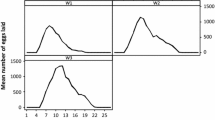Abstract
Under laboratory conditions (temperature of 26 °C and humidity of 90–95%), the development of O. alactagalis from egg to adult lasts from 5 to 10 months. All life stages feed; bloodsucking usually lasts between several minutes to 1 hour. Attachment of larvae on mice takes 1–4 h and moult to first stage nymphs occurs after 9–20 days. Female development includes 3–4 nymphal stages. For males, 2–3 nymphal stages exist. After 52–120 days of feeding, females oviposit; incubation lasts 19–32 days. Survival of wild specimens in the laboratory was reported to be longer than 6 years. Ornithodoros alactagalis ticks are found in burrows of animals, such as rodents (including Psammomys obesus, Cricetus cricetus, Phodopus spp., Meriones spp., Mus musculus, Arvicola spp., Allactaga spp.), badgers (Meles spp.), foxes (Vulpes spp.) and hedgehogs (Hemiechinus auritus); it was associated also with lizard and green toad burrows (Bufo viridis). Ornithodoros alactagalis ticks may show aggressive behaviour towards humans and researchers reported attacks when approaching animal burrows.
Access provided by CONRICYT-eBooks. Download chapter PDF
Similar content being viewed by others
Life Cycle and Host Preferences
Under laboratory conditions (temperature of 26 °C and humidity of 90–95%), the development of O. alactagalis from egg to adult lasts from 5 to 10 months. All life stages feed; bloodsucking usually lasts between several minutes to 1 hour. Attachment of larvae on mice takes 1–4 h and moult to first stage nymphs occurs after 9–20 days. Female development includes 3–4 nymphal stages. For males, 2–3 nymphal stages exist. After 52–120 days of feeding, females oviposit; incubation lasts 19–32 days. Survival of wild specimens in the laboratory was reported to be longer than 6 years (Filippova 1966). Ornithodoros alactagalis ticks are found in burrows of animals, such as rodents (including Psammomys obesus, Cricetus cricetus, Phodopus spp., Meriones spp., Mus musculus, Arvicola spp., Allactaga spp.), badgers (Meles spp.), foxes (Vulpes spp.) and hedgehogs (Hemiechinus auritus); it was associated also with lizard and green toad burrows (Bufo viridis) (Filippova 1966; Soneshine et al. 1966). Ornithodoros alactagalis ticks may show aggressive behaviour towards humans, and researchers reported attacks when approaching animal burrows (Filippova 1966).
Ecology
The habitat of O. alactagalis is essentially moist burrows, which are not excessively damp. It inhabits beaches, deserts and mountainous areas covered with desert or steppe vegetation (Soneshine et al. 1966). In Azerbaijan and Armenia, larvae were observed by the end of June and beginning of July, and nymphs and adults were observed during June. Oviposition occurs from April to December (Filippova 1966).
Distribution
Ornithodoros alactagalis was reported only in the Palaearctic region, in Armenia, Azerbaijan, Georgia, Iran, Northern Caucasus, Azerbaijan and Turkey (Manzano-Román et al. 2012).
References
Gugushvili GK (2013) Duration of preservation of Borrelia by ticks Ornithodoros verrucosus Ol., Sass. et Fen. and Ornithodoros alactagalis Issaak. AGRIS. 185–188 (In Russian)
Filippova NA (1966) Argasid ticks (Argasidae). Fauna SSSR. 4: 1–255 (In Russian)
Manzano-Román R, Díaz-Martín V, de la Fuente J, Pérez-Sánchez R (2012) Soft ticks as pathogen vectors: distribution, surveillance and control. Parasitology 7:125–162
Sonenshine DE, Clifford CM, Kohls GM (1966) The Systematics of the Subfamily Ornithodorinae (Acarina: Argasidae). III. Identification of the larvae of the eastern hemisphere. Ann Entomol Soc Am 59:92–121
Author information
Authors and Affiliations
Corresponding author
Editor information
Editors and Affiliations
Rights and permissions
Copyright information
© 2017 Springer International Publishing AG, part of Springer Nature
About this chapter
Cite this chapter
Kleinerman, G., Baneth, G. (2017). Ornithodoros (Pavlovskyella) alactagalis Issaakjan, 1936 (Fig. 18). In: Estrada-Peña, A., Mihalca, A., Petney, T. (eds) Ticks of Europe and North Africa. Springer, Cham. https://doi.org/10.1007/978-3-319-63760-0_14
Download citation
DOI: https://doi.org/10.1007/978-3-319-63760-0_14
Published:
Publisher Name: Springer, Cham
Print ISBN: 978-3-319-63759-4
Online ISBN: 978-3-319-63760-0
eBook Packages: Biomedical and Life SciencesBiomedical and Life Sciences (R0)





